
Nyack High School senior and Rockland Climate Alliance founding member Lucinda Carroll testifying against Suez Water at a May 22 hearing in Clarkstown Town Hall
by Bill Batson
On May 22, at around 11:00p, I rose to the podium in the auditorium of Clarkstown Town Hall to invoke the name of June Sundvik. As a first time author at 88, June had published Life on Old Mill Road from 1750 to 1950. She had given her last measure to complete a book about the road that she was born on in 1929. As I sat at a forum where the fate of Old Mill Road was being decided, I knew she would want her work to speak for her, and in defense of the homes, family’s and habitat that she so loved.
The idea for the book started when she came across papers and artifacts removed from the basement of a home that was condemned to create Lake DeForest. Sundvik’s volume chronicles her family’s history as well as stories of her neighbors, some of whom were noteworthy creatives including stained glass artists Clement and Maurice Heaton, illustrator Noel Sickles and the actor George MacReady. Her father, Gustav Svahn, was a very prominent builder responsible for 10 homes on Old Mill Road and many others throughout the region.
Public Meeting on Suez Water HQ on Lake DeForest
PLANNING BOARD MEETING
AUDITORIUM
JUNE 5, 2019
a) Salute to the Flag
6:30 P.M. CONTINUATION OF REVIEW UNDER THE PROVISIONS OF S.E.Q.R. & PUBLIC HEARING AT PRELIMINARY: SUEZ WATER NEW YORK HEADQUARTERS, SL 59.10-1-1 (FKA 91A8) WEST NYACK (Proposal for the relocation of the SUEZ administrative offices, storage yard and associated site improvements. The parcel is located on 26 acres of LO zoned land on the east side of Old Mill Road, approximately 685 feet south of (sic) Fulle Drive in West Nyack).
10 Maple Avenue, New City
Clarkstown Planning Board
Gilbert Heim
Chairman
Rudolph Yacyshyn
Vice Chairman
Board Members
Edward Bertolino
Phillip DeGaetano
Edward J. Guardaro
Douglas Katz
Peter Streitman
Diane Papenmeyer
Secretary
As evidence, June’s book provides the base line comparison to show the impact of decades of development on Old Mill Road. The 2019 State Environmental Quality Review Act (SEQR) handbook states that “changes in population patterns or community character likely to be induced by a project have been held by the courts to be relevant concerns in environmental review”(see Chinese Staff and Workers Association et al., v. City of New York et al,1986).
One of the structures that June describes in Chapter 17 of her book is the John Tourner house, which is possibly the oldest in the County. The structure, which Tourner was removed from for being a Tory, is part of a local network of historic sites on or near Old Mill Road that include Storms Tavern, and the historic markers at the 4 corners in West Nyack at the other end of Old Mill, one discussing Washington’s encampment, another identifying the corners as Pye’s Corner, and a 3rd on Colonial Clarkstown that states “Ancient Indian Trails intersected at this place.”
Local historic homes and markers, along with the experience of local residents who live and/or drive on Old Mill Road should give us the common sense to prevent excessive truck traffic anywhere near this location.

Wildlife photographer Ray Wright expressing concern on how overdevelopment will impact his beloved bald eagles, that only recently returned to Lake DeForest
A hastily called meeting of the Clarkstown Planning Board is now scheduled for June 5 at 6:30p to discuss a traffic study on the Suez proposal. I urge all interested in Rockland history, and its future, to attend.
This will be the third meeting in a month on Suez Water Company’s plan to build their headquarters, and station a fleet of over 100 vehicles, on the banks of Lake Deforest, our source of drinking water.
At a contentious meeting on May 22, Planning Board Members were visibly surprised to learn that a year-long repair of Snake Hill Bridge would occur at the same time that Suez would be staging their fleet of commercial vehicles on Old Mill Road. The resulting traffic from Suez would be redirected through residential streets, including historic Old Mill Road.

Ray Wright and Nyack Sketch Log author and illustrator Bill Batson at the May 22nd hearing
After publicly expressing their frustration at the news of contemporaneous bridge construction, the planning board demanded a traffic study. After on-the-spot community input suggested an interval for public review, the board announced a meeting date of June 19th.
While meeting with Clarkstown Supervisor George Hoehmann on June 1, activists expressed their own shock that the meeting date had been precipitously switched to June 5th. The community would not have two weeks, but two days to review the traffic study.
Residents began to receive the 169 page report by email on Monday, June 3rd. Neighbors of this site had less than 48 hours to work, sleep, care for their families and read this report. One resident wrote, as well, “The community would like to have an independent consultant review this study as well but we find ourselves in a situation where that can hardly be possible since the planning board has rescheduled the meeting from June 19th to June 5th, less than 44 hours away.”
 In the pursuit of meeting the lowest rung of legal requirements, Suez has abandoned any pretense of making a good faith effort to inform the public. Legitimate concerns and rights are being trampled in the rush to build a facility inappropriately close to a critical natural resource. Clear cutting trees in one of the few remaining pristine natural habitats near the reservoir adds arboreal injury to this civic assault.
In the pursuit of meeting the lowest rung of legal requirements, Suez has abandoned any pretense of making a good faith effort to inform the public. Legitimate concerns and rights are being trampled in the rush to build a facility inappropriately close to a critical natural resource. Clear cutting trees in one of the few remaining pristine natural habitats near the reservoir adds arboreal injury to this civic assault.It is said that the most deadly place in Africa is between a hippo and the watering hole. The only thing standing between Suez and our watering hole, Lake DeForest, is the public, the seven members of the planning board and every elected official in Rockland County whose constituents need access to safe drinking water.
The only difference between Suez and the hippo in my analogy is that hippos don’t need permission to stampede. Suez can be turned back through the courts of law and public opinion. Join this fight before it’s too late and the only watering hole in Rockland County is no longer safe for anyone, hippo or human, to drink.
Here’s my column about June, her book, and Old Mill Road from November 14, 2017. Copies of her book are hard to find. However, after June 5, the Planning Board of Clarkstown will have a copy.
Nyack Sketch Log: 1st time Author at 88 Chronicles Old Mill Road
 I met Rockland County’s newest author when she was 85 at a book talk I gave at Valley Cottage Library. “I’m writing a book and you’re going to help me self-publish,” she informed me. “Sure,” I replied, thinking I would never hear from her again. Two years later, I answered a call from an unknown number and heard the party say, “I’m done writing. Let’s get this published. You promised.” That determined voice was a force of nature named June Sundvik.
I met Rockland County’s newest author when she was 85 at a book talk I gave at Valley Cottage Library. “I’m writing a book and you’re going to help me self-publish,” she informed me. “Sure,” I replied, thinking I would never hear from her again. Two years later, I answered a call from an unknown number and heard the party say, “I’m done writing. Let’s get this published. You promised.” That determined voice was a force of nature named June Sundvik.
My bluff had been called I never expected June to call back. The way forward required acknowledging a tragedy. June sought my guidance because I had self-published Nyack Sketch Log Volume I. However, without the wisdom and dry wit of Jim Hershberger, my tome would have never made the book store shelf. Jim was a retired executive who made it his second life’s mission to provide tech support to historical societies and non profits and tail-gate every Giants home game. Jim vetted printers, compared notes with other self-published authors and helped me organize my sketches, essays and thoughts. The only way that I was able to help June was by reverse engineering what Jim did for me. Jim passed away on November 11, 2016. His loss is profound, but so is the continued resonance of his generosity.

Author June Sundvik
June Sundvik was able to draft like a cyclist in the wake of Jim’s hard and smart work, channeled through me, to publish an exceptional local history entitled Life on Old Mill Road from 1750 to 1950. Her family moved to Valley Cottage from Teaneck, New Jersey to a property that her grandfather, Carl Anderson, purchased in 1927. Her father, Gustav Svahn, was a very prominent builder responsible for 10 homes on Old Mill Road and many others throughout the region.
With the help of fellow Swedish immigrants, Svahn built a garage, a flat-roofed four-bedroom house, dug a pond, created a cause way and an island in the pond, and expanded the original flat-roofed house to three-stories with a cathedral ceiling living room, among other structures, for his family. The man-made and augmented natural features were so impressive that Charles and Ann Lindbergh were seen admiring the property from the road.
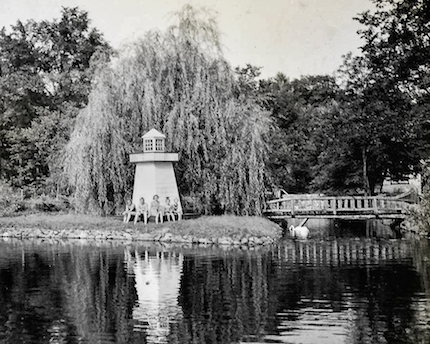 In July of 1928 Gustav and his wife Clara made June, the youngest of three. June’s personality was clearly shaped by her father’s blizzard of building. In how she wrote about her father, you can see the genesis of June’s aesthetics, resourcefulness and resilience. “Besides being a builder, he loved gardening and flowers,” she wrote of her father. “He landscaped the property with plantings; some were formal, but most were placed in natural settings. The hillsides were dotted with daffodils, climbing roses grew around the pond, and rock gardens were tucked away along the paths.”
In July of 1928 Gustav and his wife Clara made June, the youngest of three. June’s personality was clearly shaped by her father’s blizzard of building. In how she wrote about her father, you can see the genesis of June’s aesthetics, resourcefulness and resilience. “Besides being a builder, he loved gardening and flowers,” she wrote of her father. “He landscaped the property with plantings; some were formal, but most were placed in natural settings. The hillsides were dotted with daffodils, climbing roses grew around the pond, and rock gardens were tucked away along the paths.”His prolific construction projects also betrayed a playful aspect. He built a miniature lighthouse, a shed for their beloved swans, Hansel and Gretel to winter in, a playhouse for the children, houses for the dogs. June’s hobby horse was deployed as a weather vane on a barn. His daughter June, pictured here playing at the base of the lighthouse, would go on to become an accomplished weaver and water colorist and now, a published author.
Life on Old Mill Road
by June Sundvik
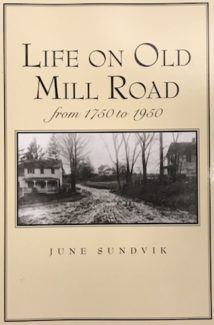
June gave a book talk at the Valley Cottage on Wednesday, November 15, 2017 that was extremely well attended.
She described her research process, read some passages, took questions.
June never presented herself as a historian, but a writer sharing the recollection of her neighbors.
I will be forever inspired by her dogged determination to complete her book before her body betrayed her, extinguishing one of the brightest minds I have had the good fortune to encounter.
Editing her thin volume was one of the weightiest honors of my life.
This story started many years ago when I was taking home an old neighbor friend, Catherine Daniels, who had been helping me clean house,” June said. “She asked me if I was interested in some old books and artifacts from the old Fisher farm, which also had been torn down in 1933. She began writing in earnest when she was given a wooden chest full of old deeds and title search from her sister, Stina. Because I lived on Old Mill Road almost all my life, and remembered many of the families I decided to tell the story about their lives and the history of the homes they lived in. Although I included a few homes on the West Nyack part of the road, I concentrated on those that were in Valley Cottage, beginning where the Kill Von Beaste flows into the Hackensack River, north to Kings Highway.
 The result is, like June, artistic and sturdy. Her words are illuminated by historic family photos, many carefully restored by Dr. Arnold Roufa. She narrates with the economy of a no-nonsense story teller who gets out of the way of her subjects. One of my favorite extended passages (1,144 words) is a an oral history taken by a granddaughter, Dotty Larson describing her grandmother’s somewhat scandalous, poignant and epic love affair with a man she was hired to serve as a housekeeper and cook.
The result is, like June, artistic and sturdy. Her words are illuminated by historic family photos, many carefully restored by Dr. Arnold Roufa. She narrates with the economy of a no-nonsense story teller who gets out of the way of her subjects. One of my favorite extended passages (1,144 words) is a an oral history taken by a granddaughter, Dotty Larson describing her grandmother’s somewhat scandalous, poignant and epic love affair with a man she was hired to serve as a housekeeper and cook.
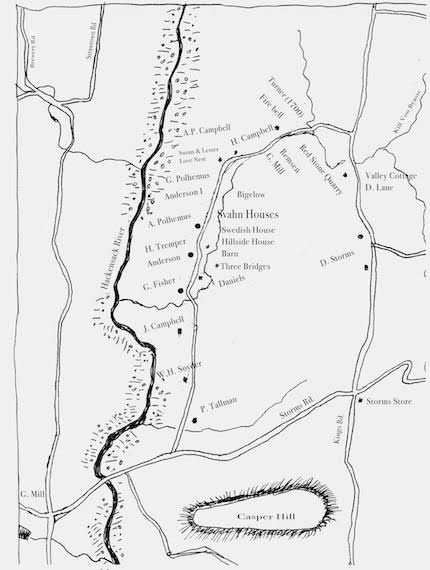 Her final job was when she became the housekeeper/cook for Lester Polhemus on Old Mill Road in Valley Cottage. They became something of a love match between two adults who had buffeted in life and were happy to be in each other’s company for the final stretch.
Her final job was when she became the housekeeper/cook for Lester Polhemus on Old Mill Road in Valley Cottage. They became something of a love match between two adults who had buffeted in life and were happy to be in each other’s company for the final stretch.
The little house where Susan and Lester lived had only two rooms with an attached summer kitchen. It was full circle for Susan because it was similar to the one she lived in as a child in Glen Cove. It had no electricity, no running water, and was heated by a large iron wood stove that had become popular after open-hearth cooking became outdated. For furniture, there was an oak gate leg table, straight back chairs and a large floor to ceiling wooden breakfront with glass doors and drawers below for storage. A daybed was used for sleeping or seating in the main room. The bedroom had a large feather bed draped in white quilts and pillows. There was a hand-crafted blanket chest made of pine by local artisans.
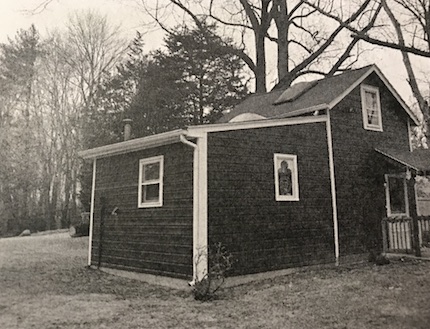
Susan and Lester’s Love Shack
There is a contemporary photo of their love shack taken by June’s son, Carl Sundivk. The structure still stands off Old Mill Road and should have a plaque.
As much as one might find a strong influence of the father in June’s life, Old Mill Road it self became her mentor. A litany of creatives seems to gravitated to the spot that the Lindberghs found so alluring.
During the last 50 years, these extraordinary artists live on Old Mill Road:
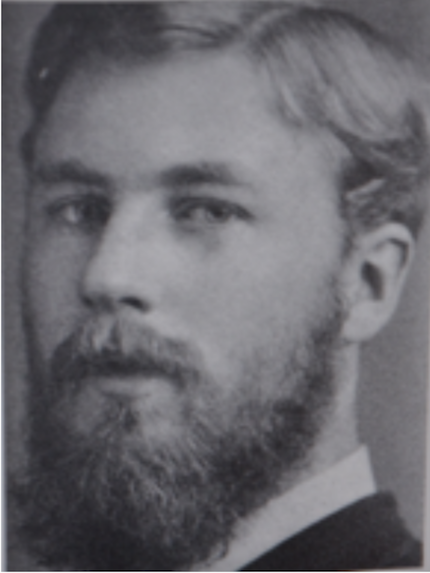
Clement Heaton
Clement and Maurice Heaton
Clement Heaton was born in England to a family of glass makers, and decorators and had connections with William Morris. He works were sold in London, Paris,Vienna and Berlin. He bought mill house he was able to build the framework for his stained glass windows, and there he was able to make important windows for St John’s Cathedral in New York.
His son Maurice continued the art of glass making and develops a method of enameling on glass. With a group of fellow artists he founded the Rockland Center for the Arts, and even had a studio named for him. He was honored by the Smithsonian by having a piece of his work in their glass collection.
Robert Pinard
A renowned stained glass maker, moved from France to the US in 1951. Pinart transformed darker stained glass images by creating new glass scenes that allowed light to enter the churches. His works can be seen in the National Cathedral in Washington.
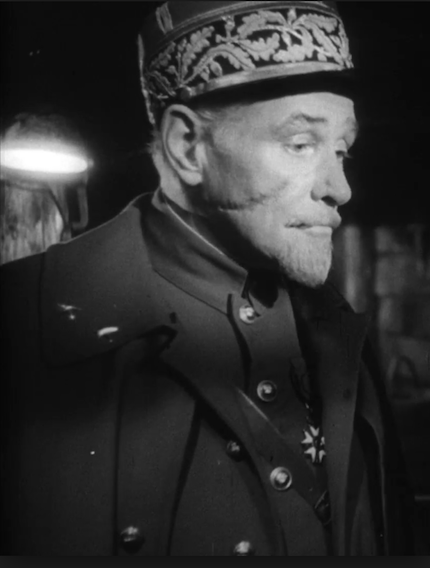
George Macready
Thomas George
George was an artist who studied in Paris and Florence. He was fascinated with the mountains in Norway and spent many summers there, painting them. He was the son of the famous Rube Goldberg, and while living on Old Mill Road had a large celebration for his father’s 80th birthday in the field across the stream from the house
Noel Sickles
Sickles shared a studio with Milton Caniff who was working for the Columbus Dispatch. Both men moved to New York City and worked for the Associated Press, where they worked together for two years, often drawing each other’s comic strips. He had an impressionist style of inking and proved to be adept at using a shading called zipatone. When LIFE published Hemmingway’s Old Man of the Sea, Sickles was the illustrator. Some say he was the best illustrator ever.
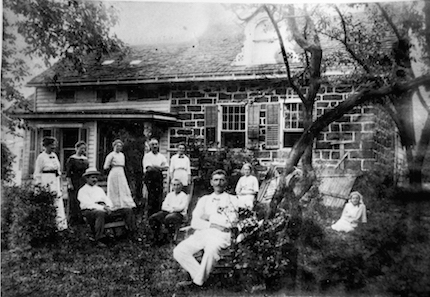
Carl Anderson
George Macready
George was an actor on Broadway and Hollywood. He was a good friend of Vincent Price, and at one time they had an art gallery together. George was well known for his part as Rita Hayworth’s husband in Gilda.
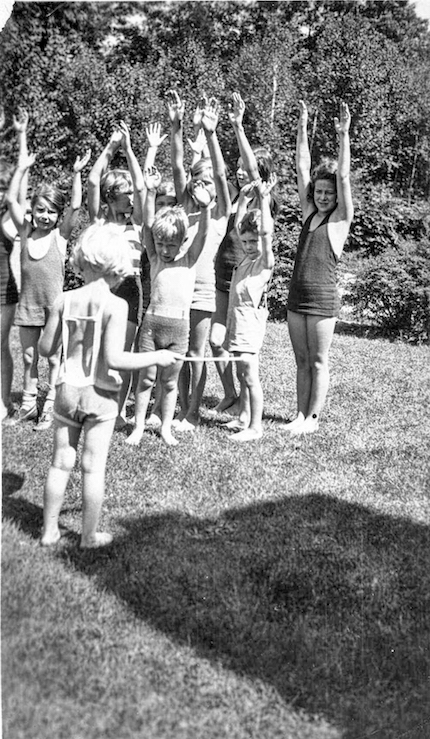
A four-year old June Sundvik conducting Marguerite Heaton’s dance class
There are too many stories that surround us and not enough story tellers. From my experience sketch logging in the effort to preserve and animate local history, I met June and other Rocklanders who share their tales full of pathos and profundity.
I invited June to meet my class the Learning Collaborative at the New City Jewish Center on six different occasions, but she had to cancel each visit because of her health. Her well attended book talk on Wednesday, November 15, 2017 was her first and last.
I am hoping that June’s example will encourage others to liberate their family photos from dusty albums, dare to scribble down some thoughts, or sketch out some memories and cook up some books full of the recipes for living that we all inherit or invent, but often fail to pass down.
I’ll let June have the last word:
“Every road and every house has a story, which is ongoing, and what I have written is only a small window into the lives of the neighbors that lived on Old Mill Road starting with the early settlers of the 1850s and through the changes that were made and homes that were added for the next 100 years to the time that the reservoir was built. Much of this information came from old records, and the fact that I knew many of the families, as we were a neighborhood, often depending on each other.”









